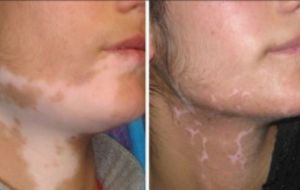Vitiligo results in the development of white patches or depigmentation on the skin’s surface, and it can significantly impact a person’s appearance and self-esteem. Vitiligo is a chronic skin disorder that occurs when melanocytes, the cells responsible for producing the pigment melanin, are destroyed or become dysfunctional. Melanin provides color to the skin, hair, and eyes, and its absence in specific skin areas results in the formation of white patches. The exact cause of vitiligo remains complex and not entirely understood, but it is believed to involve a combination of genetic, autoimmune, and environmental factors. Vitiligo can affect individuals of any age, gender, or ethnicity, and its progression varies from person to person. The condition can have a profound impact on a person’s self-esteem, as it often leads to conspicuous and contrasting depigmented areas, which may become more prominent over time. Vitiligo is not contagious or life-threatening, but it can be emotionally distressing. Patients often experience feelings of self-consciousness, social stigmatization, and a reduced quality of life due to their altered appearance. Understanding the nature of vitiligo is crucial for both affected individuals and healthcare providers in order to explore appropriate treatment options, such as vitiligo surgery, to manage the condition.
Book Your Appointment
Book Your Appointment

What is Vitiligo?

Who gets affected by Vitiligo?
Vitiligo can affect at any age, to all races and sexes at any age. Its visibility is more in dark-skinned people. People who have other autoimmune conditions like Daibetes type I, Psoriasis, Thyroid, Lupus, Addison’s disease, Psoriasis, and Rheumatoid arthritis are more prone to Vitiligo
Vitiligo starts as a few small patches or white macules and can gradually spread over the body. Patches can appear on any part of the body including mucous membranes (moist lining of genitals, nose, mouth, etc), eyes, and inner ears.
Patches can sometimes spread and increase in size with time or may just remain the same over the years.

Types of Vitiligo
1. Generalized: The most common type of vitiligo that causes patches to appear in various places on the body
2. Segmental: This affects only one side of the body or one area of the body like the hands or face
3. Mucosal: It affects the mucous membrane of the genitals or mouth
4. Focal: It is a rare type. In this patches develop in a small area and they do not spread in certain patterns within a couple of years
5. Trichome: This appears as a bullseye with a white center and lighter pigmentation and lastly a natural skin tone.
6. Univeral: This causes more than 80% of the body area to be affected and does not have any pigment
ue to their altered appearance. Understanding the nature of vitiligo is crucial for both affected individuals and healthcare providers in order to explore appropriate treatment options, such as vitiligo surgery, to manage the condition.

Causes of Vitiligo
1. Autoimmune condition: Any autoimmune condition where the body’s immune system starts attacking your healthy cells can lead to the development of vitiligo, as this makes the immune system develop antibodies to destroy melanocytes as well.
2. Genetic Changes: A genetic mutation can affect how melanocytes function inside the body. Changes can lead to a risk of developing vitiligo
3. Stress: The amount of pigment production can be affected due to increasing stress or frequent changes in emotional or physical stress in the body
4. Environmental trigger: Toxic chemicals and UV radiations can also affect the melanocyte cell function.

Management and Treatment of Vitiligo
As vitiligo is not harmful the treatment plans can help improve the physical appearance. These treatment options help us to achieve uniform skin tone over successive sessions. Some of the effective treatment options are:
1. Medications: Topical medications can help bring the color back over a period of time. Like corticosteroids, Calcineurin inhibitors, etc.
2. Light Therapy: Phototherapy or Narrow Band UVB treatment uses UV light to stimulate the cells to bring the color back. This can be done for small patches or even bigger areas. Multiple sessions are recommended for this treatment.
3. Depigmentation Therapy: It helps remove the natural skin color of the remaining area to match it with the affected areas
4. Surgery: Vitiligo surgery is a specialized medical procedure aimed at treating vitiligo. Vitiligo surgery involves the removal of healthy melanocytes from one part of the patient’s body and their transplantation to the depigmented areas. The primary objective of this surgical approach is to repopulate the affected skin with functional melanocytes, thereby restoring pigment and reducing the contrast between the depigmented and normally pigmented skin. Several techniques are utilized in vitiligo surgery, including suction blister grafting, split-thickness grafting, and cultured melanocyte transplantation. While not a cure for vitiligo, these surgical procedures can be highly effective in repigmenting the skin and improving the cosmetic appearance of affected individuals, offering a ray of hope for those living with this condition.

Prevention Tips
As there can be several causes of it, there is no specific prevention manual for vitiligo. You can practice the right habits to reduce the risk of developing it:
1. Practice safe sun exposure with the right sunscreen application.
2. Following the right skincare routine daily as per your age and skin type
3. Avoiding stress or injury to your body
4. Managing underlying issues or other autoimmune conditions
Following the right routine, a healthy diet, and a proper lifestyle is the key to keeping your body healthy and skin glowing. It is always best to consult your doctor in case of any such signs and symptoms to diagnose the problem and early stage and control it with the right plan.

Other Services Offered
Explore the diverse spectrum of services at Dr. Haror’s Wellness, where we specialize in crafting personalized experiences to cater to your individual requirements. Your transformative journey towards a ‘new you’ starts here!

Expertise personified:
Meet the Guru
Founded and led by Dr. Navnit Haror, a pioneer in aesthetic medicine. He is a dermatologist and hair transplant surgeon, widely recognized as a practitioner and expert in Aesthetic Surgery.
Visit our modern facility, meticulously crafted with five spacious treatment chambers, two advanced procedure suites, and a welcoming reception zone. Our specialised Vitiligo Treatment sessions meet the most stringent global benchmarks, guaranteeing your utter comfort and contentment during the process. Experience a welcoming ambiance on the day of your Vitiligo Treatment, fostering tranquillity and revitalization. Our capable and friendly staff, fully immunised and meticulously vetted for health, stands with you every step of the way, offering unwavering encouragement as you progress toward a more uniform and self-assured skin tone.
Dr. Navnit Haror
Gold Medalist | Dermatologist| Hair Transplant Surgeon

Our Doctors
We are founded, managed, and led by one of the world’s finest Aesthetic Surgeons, Dr. Navnit Haror and Dr. Vineeta Pathak.

Dr. Navnit Haror
Gold Medalist | Dermatologist| Hair Transplant Surgeon
Internationally acknowledged as a domain expert and practitioner of Aesthetic Surgery, Dr. Navnit Haror is a Dermatologist and Hair Transplant surgeon in practice since 2012 and is the Founder-Director of Dr. Haror’s Wellness. He has trained over 12,000 clinicians and doctors in hair transplantation techniques across 17 countries.

Dr. Vineeta Pathak
Consultant Cosmetologist | Hair Transplant & Aesthetic Surgeon
An award-winning dermatologist, Dr. Vineeta Pathak specializes in cosmetic dermatology and all aesthetic procedures. Her expertise includes vitiligo surgeries and ear lobe reconstruction, permanent hair reduction, hair transplants, lasers, and all aesthetic procedures among others.

FAQs
Empower yourself with knowledge and make informed decisions as you find answers to commonly asked questions about our services
Is there a cure for vitiligo?
While there is no cure for vitiligo, various treatments can help manage the condition and improve the appearance of the skin.
How effective are vitiligo treatments?
Some individuals may experience significant repigmentation, while others may have more limited results.
Can vitiligo treatments completely restore my skin colour?
Complete restoration of skin colour is not always possible, but many treatments can lead to noticeable improvements in pigmentation and overall skin appearance.
How long does it take to show results?
Some individuals may experience significant repigmentation, while others may have more limited results.
How long does it take to show results?
The timeline varies based on the treatment. Some treatments may show improvement within a few months, while others require several sessions over weeks or months.
Is vitiligo treatment covered by insurance?
Coverage varies depending on your insurance provider and policy. It’s advisable to check with your insurance company.





